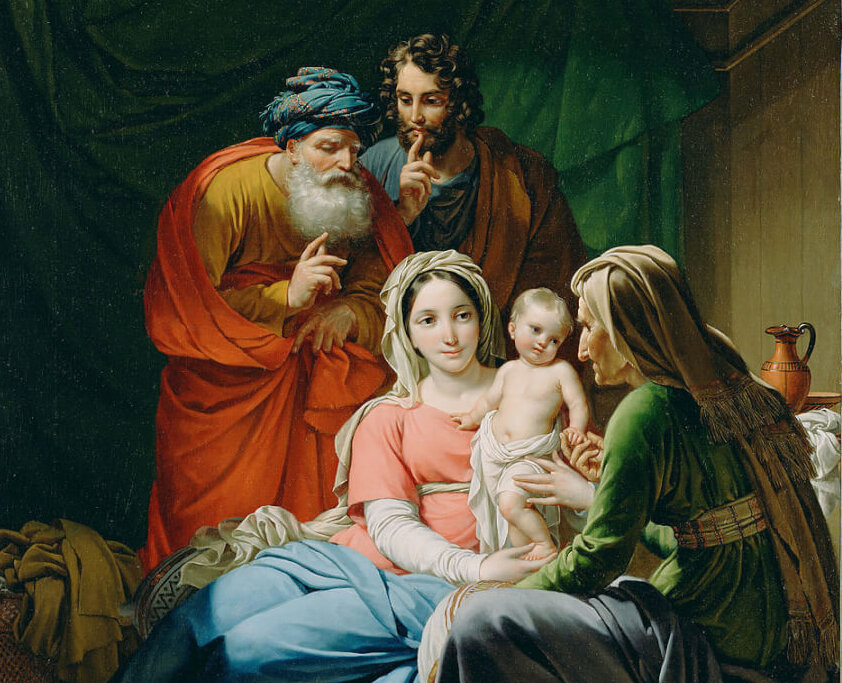This summer, you may be using some of your vacation to visit relatives—your parents, perhaps, or your grandparents, if they’re still living. July 26th is the Feast of Saints Joachim and Anne — the parents of the Blessed Virgin Mary and the grandparents of Jesus. And they weren’t too far away for the Holy Family to visit!
According to an early Church tradition, the Blessed Virgin Mary hailed from Sepphoris, where she lived with Saints Joachim and Anne, located about four miles north of Nazareth. Sepphoris, which Roman historian Josephus called “the ornament of all Galilee,” was the largest and one of the most important cities in the area. In fact, a highway linking the two other major regional centers — Caesarea Maritima and Tiberias — was not far from Nazareth and Sepphoris.
It is also possible that Joseph and Jesus worked in Sepphoris during its period of heavy expansion under Herod Antipas from 4 B.C. to A.D. 39. The Greek word tekton — which the Gospels employ to describe Jesus’ and Joseph’s occupation — actually means much more than “carpenter.” In fact, it is likely that Joseph and Jesus would have had architectural abilities as well. One might even say they were the equivalent of modern-day engineers.
Sepphoris is a potential boon for understanding and clarifying certain aspects of Jesus’ teachings — especially as recorded in the Gospel of Matthew. The “city set on a hill [that] cannot be hidden” (Matt. 5:14) may have been inspired by Sepphoris, which was elevated. Its evening lights would have been visible to the inhabitants of Nazareth.
Excavations at Sepphoris also reveal a splendid public theater, carved out of the local bedrock and initially seating about 2,500. Could it be that Jesus and Joseph worked on its construction? Jesus’ references to “hypocrites” (Matt. 6:2, 5, 16; 7:5; 15:7; 16:3; 22:18; 23:13-15, 23, 25, 27-29; 24:51; Luke 6:42; 11:44; 12:1, 56; 13:15), an originally innocuous word that referred to “actors” or “play-actors,” may have been expropriated from the theater at Sepphoris. Jesus used the term to excoriate the people-pleasing, insincere piety of some scribes and Pharisees.
Jesus likewise admonishes his disciples not to practice their piety “before people, in order to be seen by them” (Matt. 6:1). The term translated as “to be seen” is the Greek word theathenai, from which is derived the English word “theater”. Jesus teaches: “Do not be like the hypocrites; for they love to stand and pray in the synagogues and at the street corners, so that they may be seen by others” (Matt. 6:5). This may allude to an actor who stands and performs a soliloquy on stage. In contrast, Jesus encourages us to live not for the applause of others but rather for the applause of One: God alone.
This feast can be a great reminder to pray for our own grandparents, and for their repose if they have passed into eternity. I’m always amazed by how many people I meet who say that it was a grandmother or grandfather who introduced them to a living relationship with Jesus Christ. And if you’re a grandparent yourself, don’t underestimate the spiritual impact you can have on those around you.
Saints Joachim and Anne, pray for us!

Our Lady is celebrated under many names, from popular apparitions to small-town titles. Each reveal something different about the Blessed Mother to us – and affirms what we already know of her love and intercessory power! Deepen your devotion to Our Lady with Miracles, Mysteries, & Mary, a monthly collection of stories, Church teaching, reflections, and so much more – guaranteed to expand your knowledge of Our Blessed Mother. Sign up today to receive this Marian content, right to your inbox, and check out our archive page to catch up on our year of Our Lady!



